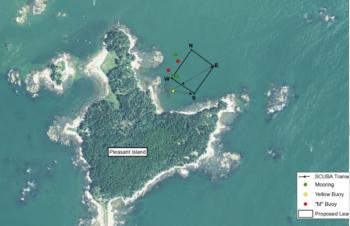Mussel Ridge scallop, oyster aquaculture proposal to be aired in Thomaston
A proposal to site an oyster and scallop aquaculture farm in a cove on Pleasant Island in Mussel Ridge Channel will be heard this evening at a Dept. of Marine Resources public hearing in Thomaston.
The hearing begins at 6 p.m. at Watts Hall.
The Maine Mariculture Company LLC, with four principals and a business address at Merchant’s Landing in Spruce Head, specifies the 3.62-acre site at Home Harbor, at the northeast side of Pleasant Island.
The cove site there is shallow, 25 feet of water at high tide and 15 feet at low tide. The bottom, according to the application filed with the Maine Department of Marine Resources, is muddy and rocky, with rockweed and eelgrass.
The lease application is for 10 years, and the species to be cultivated are American or Eastern oysters, and sea scallops.
Mariculture hopes to eventually produce 1.4 million oysters and 610,000 scallops per year. When producing to those levels, the company said it intended to hire 10 part-time and full-time employees, depending on market conditions and production effectiveness.
The principals involved in Mariculture are Brendan Atwood and Genevieve Atwood, of Winooski, Vt.; Darrald Atwood, of Oxford, Ct.; and Ryan Atwood, of Stamford, Connecticut.
Maine Mariculture owns much of the gear already, according to the application, and would obtain a $5,000 performance bond.
Oyster seed is to be obtained from Muscongus Bay Aquaculture, in Bremen, and Mook Sea Farms, in Walpole.
The wild scallop spat is to be caught by licensees Brendan and Darrald Atwood.
The company is proposing to grow scallops on ropes that hang vertically in the water, with approximately 70 scallops per line. The rope lines are to be attached to transverse lines, at a maximum of 185 vertical lines per 240-foot transverse line, with a maximum of 13,000 scallops per transverse line.
A projected maximum quantity of scallops grown by ear-hanging is 250,000, according to the Oct. 14 lease application.
The lines would be delineated by buoys on the surface. The transverse lines would be chained to 1,000-pound granite moorings.
The oysters would be raised in cages.
To control fouling, the company said it would flip the cages every seven to 21 days for up to 24 hours, exposing the cages to air while resting on pontoons.
The site would be serviced by a 12-foot by 24-foot barge, and the production would be tendered 10 days a month between May and October for up to eight hours a day.
The oysters are secured in mesh shellfish bags.
A maximum of 900 cages are to be deployed at a given time.
“At maximum, production will occur roughly five days per week at a maximum of 10 hours during daylight, during May-November,” according to the application. “Some additional operations may be required beyond these proposed time periods and may include flipping cages periodically, thinning the number of oysters and scallops in the bags and trays and grading them, harvesting oysters and scallops on the day of shipment, and preparing the cages for winterization.”
Lobster grounds and Dept. of Marine Resources site review
On July 19, a team of Maine Dept. of Marine Resources personnel visited the site and produced its report.
The report said the “proposed lease activities are not expected to interfere with navigation in the general vicinity. Although the channel north of Pleasant Island and south of Hewett Island is navigated for both commercial and recreational purposes, boats transiting this area will not be negatively impacted by the presence of the proposed lease at any tide. The site is located greater than 1,065 feet from Hewett Island at Mean Low Water (MLW) while another location in the same channel provides only ~495 feet (MLW) between Pleasant Island and ledges south of Hewett Island.”
Contrary to the application, however, the report noted that there were 25 lobster pot buoys within Home Harbor. Mariculture had said the site is fished by five or fewer lobstermen, setting 15 traps there, near the aquaculture site.
“This location was chosen, in large part, based on the historically limited lack of fishing and recreation in the vicinity, and was chosen in consultation with commercial fishermen in that area, as well as riparian owners,” the application said.
The DMR report said: “Approximately 15 of these lobster pot buoys were located within the proposed lease area. Upon examining the site via dive transect, MDMR scientists observed that the high number of lobster pot buoys were accompanied by a high density of American lobster (Homarus americanus). At full development the proposed lease would prevent commercial lobstermen from setting lobster traps within its boundaries and would diminish their ability to operate in Home Harbor.
“No other commercial or recreational fishing activities were observed in the immediate vicinity, although recreational fishing could occur from shore and by boat in the area. Except within its immediate footprint, the proposed lease, if granted, will not hinder recreational fishing in the area.”
The DRM report said that lobster is commonly sighted within the proposed lease site, and were present in higher density on the sand and hard mud bottom within the central portion of the site. Hermit crabs are also abundant throughout the proposed lease area.
Other species observed include: Rock crab (Cancer sp.) - occasional Barnacles (Balanis sp.) - occasional Sea colander (Agarum sp) - common Filamentous brown seaweeds (Phylum Phaeophyta) – common Filamentous red seaweeds (Phylum Rhodophyta) – occasional Dulse (Rhodymenia palmata) - occasional Brushy Red Weed (Cystoclonium purpureum) - occasional Crustose Algae (Phylum Rhodophyta) - occasional Tortoiseshell Limpet (Acmaea testudinalis) - occasional Periwinkle (Littorina sp.) - occasional Eelgrass (Zostera marina) - rare Rockweed (Fucus sp) - rare Sea Lettuce (Ulva lactuca) - rare Irish Moss (Chondrus crispus)
The Mariculture aquaculture proposal joins 20 other lease applications before the Maine DMR, for spots stretching along the coast. There are already multiple leases in effect, and can be seen here: http://www.maine.gov/dmr/aquaculture/leases/decisions/index.html.
Reach Editorial Director Lynda Clancy at lyndaclancy@penbaypilot.com, or 207-706-6657





























